Method Study: Working Smarter & Improving Productivity
In today’s highly competitive industrial landscape, organizations are under constant pressure to work smarter, not harder.
This is where method study comes in as a game-changing approach. Simply put, method study is a systematic way of analyzing and improving how work is done, so tasks can be completed more efficiently, economically, and safely.
As a vital part of method study in industrial engineering, this technique focuses on identifying, recording, examining, and developing the best possible ways to perform any operation — whether it’s on the factory floor, in administrative workflows, or in service delivery. By applying proven method study techniques, companies can eliminate unnecessary tasks, reduce fatigue, minimize waste, and optimize the use of manpower, machines, and materials.
At Sugoya India, we believe that method study is more than just a productivity tool — it’s a mindset for continuous improvement. Our expertise in method study in industrial engineering helps businesses streamline operations, enhance product quality, and stay ahead in an ever-evolving market. With the right method study techniques, even small changes in how work is done can lead to significant gains in efficiency, cost savings, and employee satisfaction.
If you want your organization to stay competitive and lean, understanding and implementing method study is an essential first step towards operational excellence.
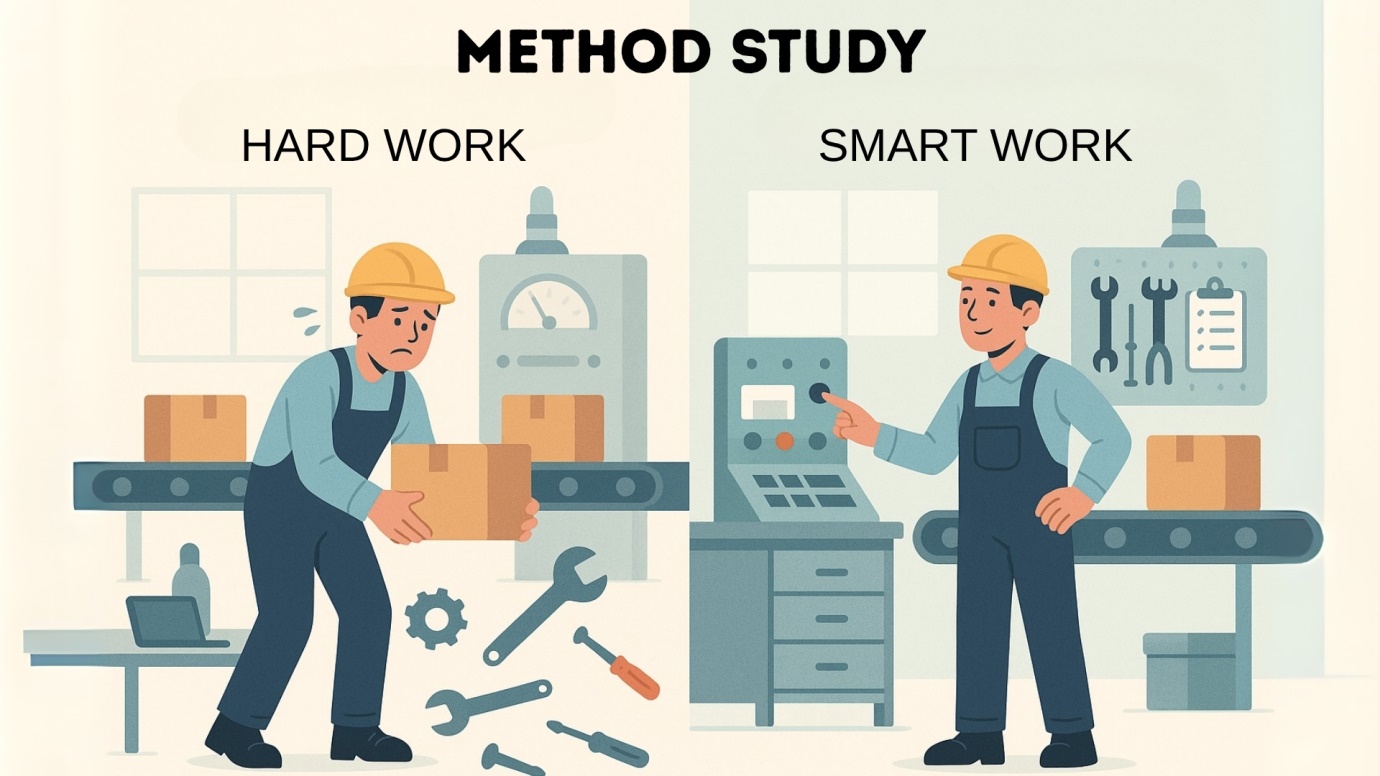
What is Method Study?
At its core, method study is a systematic process used to critically analyze how a job or task is performed and then develop a better, more efficient way to do it. In formal terms, method study can be defined as the “systematic recording and critical examination of existing and proposed ways of doing work, as a means of developing and applying easier and more effective methods while reducing costs.”
As a crucial component of Work Study, method study works hand in hand with Motion Study to achieve maximum productivity with minimum effort. While Motion Study focuses on the movements involved in completing a task, method study goes a step further — it examines the entire method or process, from start to finish.
Key Element of Work Study
Work Study is an umbrella term that includes both method study and time study. Together, they aim to find the best way to perform a task (method) and determine how long it should take (time).
Relationship with Motion Study:
- Motion Study analyzes the smallest movements of workers or machines to remove unnecessary actions.
- Method study techniques then redesign the entire workflow, sequence of operations, or workplace layout to support those efficient motions.
Relevance in Industrial Engineering:
In the context of method study in industrial engineering, this systematic approach helps manufacturing plants, service industries, and administrative systems streamline processes, reduce waste, and standardize operations for consistent quality.
Looking to implement these improvements across your operations? Explore how our Industrial Engineering Services can support your business with end-to-end solutions for sustainable efficiency.
In essence, method study in industrial engineering is about finding the best possible way to use resources — people, machines, materials, and time — so that work is done faster, with less waste, and with higher quality. By applying the right method study techniques, industries can foster a culture of continuous improvement and maintain a competitive edge.
Why is Method Study Important?
In today’s rapidly evolving industrial landscape, staying competitive means constantly finding ways to do more with less. This is where method study becomes an indispensable tool for businesses that want to work smarter and boost productivity.
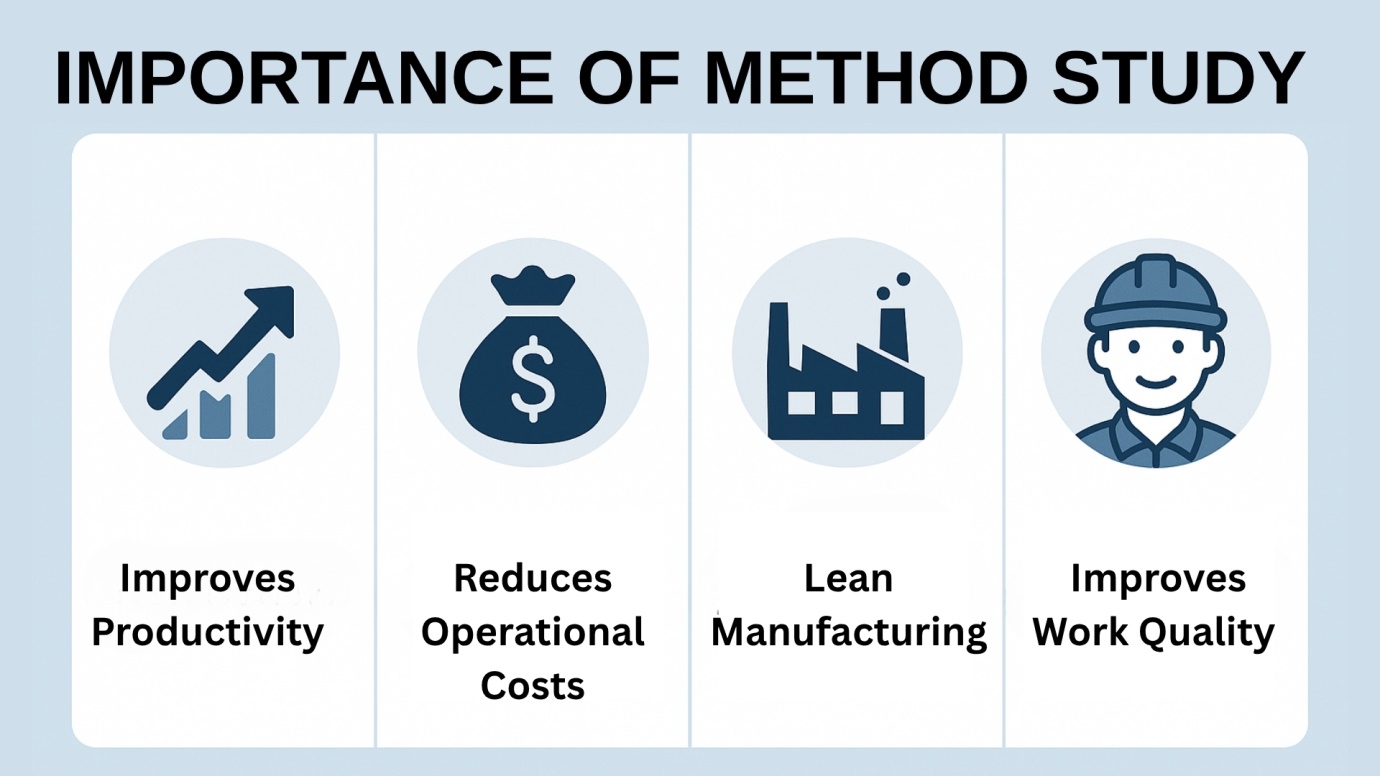
At its core, method study helps organizations identify the best way to perform a task by analyzing each step and eliminating activities that do not add value. This results in significant improvements in efficiency, better utilization of resources, and cost reduction across the board.
Here’s why method study is so vital for any modern industry:
1. Improves Productivity:
By applying proven method study techniques, unnecessary movements, bottlenecks, and redundant steps are removed. This streamlining ensures that every process flows smoothly — whether it’s on a busy shop floor or in a back-office operation.
2. Reduces Operational Costs:
One of the biggest benefits of method study in industrial engineering is its focus on eliminating waste. By optimizing workflows, organizations save on labor costs, material waste, machine downtime, and even energy consumption.
3. Supports Lean Manufacturing:
Method study aligns perfectly with lean principles, which aim to maximize value and minimize waste. Regular application of method study techniques helps companies embed continuous improvement into their culture.
4. Improves Work Quality and Employee Satisfaction:
A well-designed work method means fewer errors, less rework, and reduced worker fatigue. This leads to consistent product quality and a safer, more comfortable work environment.
The real strength of method study in industrial engineering lies in its ability to create a culture of continuous improvement. Processes are never considered perfect — they’re regularly revisited and refined using the latest method study techniques.
Whether it’s a manufacturing plant, a service operation, or an office, the practical method study examples prove that small changes in how work is done can lead to big results. Organizations that adopt method study as part of their everyday practices gain a significant edge in quality, cost-effectiveness, and overall competitiveness.
Steps in Method Study (S.R.E.D.D.I.M.)
To unlock the full potential of method study, it must be carried out in a systematic and logical manner. This ensures that no important aspect of the process is overlooked and that improvements are practical and sustainable. The proven framework that guides this process is the S.R.E.D.D.I.M. cycle — an acronym for the eight essential method study steps that every business should follow for successful implementation.

Here’s a detailed breakdown of each of the method study steps and how they connect to real-world improvements:
1. Select
The first step is to select the job, process, or activity that needs improvement. Ideally, this should be an area with high costs, significant waste, frequent bottlenecks, or safety concerns. Choosing the right project ensures maximum return on investment for the time and resources spent on the method study.
2. Record
Once you’ve identified the area for improvement, the next method study step is to record all the relevant facts about how the work is currently done. This is where various method study techniques come into play, such as:
- Process charts
- Flow diagrams
- SIMO charts
- Two-handed process charts
These tools help visualize the current method in detail, making it easier to spot inefficiencies.
3. Examine
After recording the facts, the next step is to examine each aspect of the current method critically. This involves asking probing questions like:
- Why is this step done?
- Where is it done?
- Who does it?
- When is it done?
- How is it done?
This step is where many method study examples reveal surprising areas of waste that would otherwise go unnoticed.
4. Develop
Based on the critical examination, you develop a new, better method for performing the task. This is where the ECRS principle — Eliminate, Combine, Rearrange, and Simplify — plays an important role. The goal is to create a method that improves efficiency, reduces waste, and enhances safety.
5. Evaluate
Next, you must evaluate the newly developed method to ensure it is practical, cost-effective, and beneficial compared to the old one. This involves checking its feasibility, potential cost savings, and the ease of implementation. Well-documented method study examples often show how this step prevents costly mistakes.
6. Define
After evaluation, the improved method should be defined clearly. This means documenting the new standard operating procedures in detail, including diagrams, process charts, and work instructions. Clear definition ensures that everyone understands and follows the improved method consistently.
7. Install
The install step is where the new method is put into practice. This might involve training employees, reorganizing the workspace, or introducing new tools and equipment. Effective installation requires careful planning and good communication to avoid resistance to change.
8. Maintain
Finally, it’s essential to maintain the new method. This is one of the most overlooked method study steps, but it’s critical for sustaining improvements over time. Regular monitoring, audits, and feedback help ensure that old habits don’t creep back in and that further improvements can be made when necessary.
By following these structured method study steps, businesses can unlock significant gains in productivity, quality, and cost-effectiveness. When supported by the right method study techniques, each step builds on the last to create a culture of continuous improvement.
Whether you’re analyzing complex manufacturing processes or simple office tasks, the S.R.E.D.D.I.M. framework provides a practical roadmap for driving lasting change. Well-documented method study examples across industries prove that even small changes can make a big difference when each step is approached methodically.
Tools & Techniques Used in Method Study
Implementing method study effectively relies on a strong foundation of practical tools and systematic approaches. These method study techniques help teams visualize, analyze, and improve work processes with precision. They are an essential part of the structured method study steps, ensuring that no detail is overlooked and that improvements are both measurable and sustainable.
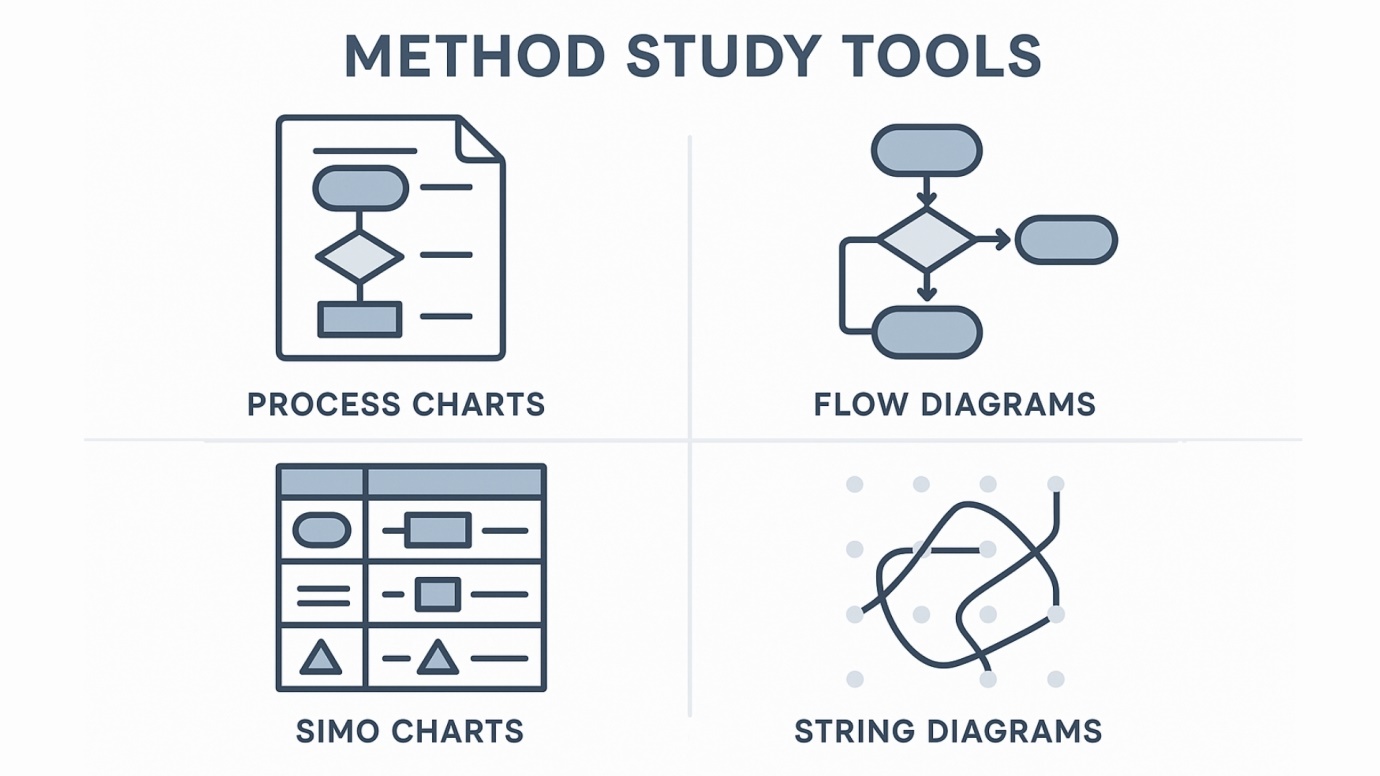
The most commonly used method study techniques:
Process Charts:
Process charts are one of the simplest yet most powerful method study techniques. They use standardized symbols to map out every step in a process, from operations and inspections to transport, delays, and storage.
Key types of process charts include:
- Operation Process Chart: Shows only the main operations and inspections.
- Flow Process Chart: Provides a detailed breakdown, covering all activities.
- Two-Handed Process Chart: Records the motions of both hands when a worker performs a task, helping eliminate unnecessary movements.
These charts are especially valuable during the Record and Examine phases of the method study steps.
Flow Diagrams:
Flow diagrams (or layout diagrams) complement process charts by providing a visual layout of the physical movement of people, materials, or information through a workspace.
They help identify:
- Excessive movement.
- Poor plant layout.
- Opportunities for rearrangement.
This makes flow diagrams a vital part of the method study techniques that support lean layouts and efficient workflows.
SIMO Charts:
A SIMO Chart (Simultaneous Motion Cycle Chart) is one of the most detailed method study techniques. It records the sequence and timing of movements performed by each hand or body part during a task.
SIMO Charts are highly useful when analyzing:
- Highly repetitive manual tasks.
- Complex operations that require coordination of different motions.
These charts play a key role in refining the finer details during the Examine and Develop stages of the method study steps.
String Diagrams:
A String Diagram is used to trace the exact path of workers, materials, or equipment on a scaled layout. By using a string to represent movement, it highlights wasted effort due to poor plant layout or inefficient flow.
String diagrams are practical method study techniques for tasks involving frequent back-and-forth movement, helping businesses to design layouts that reduce travel time and increase efficiency.
ECRS Principle: A Guiding Light for Improvement
Alongside these tools, the ECRS principle — Eliminate, Combine, Rearrange, Simplify — is a fundamental part of effective method study techniques.
- Eliminate: Remove unnecessary steps that don’t add value.
- Combine: Merge similar activities to reduce duplication.
- Rearrange: Change the sequence or location of tasks to improve flow.
- Simplify: Make tasks easier through better tools or methods.
The ECRS principle aligns perfectly with every stage of the method study steps, ensuring that improvements are practical and cost-effective.
By applying these proven method study techniques, companies can break down complex tasks, pinpoint inefficiencies, and create clear, easy-to-follow solutions. Whether you’re just starting the method study steps or looking to fine-tune existing processes, these tools provide the structure needed for lasting success.
Combined with real-world experience and a culture of continuous improvement, they transform method study from theory into a practical driver of efficiency and excellence.
Applications of Method Study
The beauty of method study lies in its versatility — it can be applied to almost any activity or process where efficiency, cost savings, and quality improvement are desired. By following the systematic method study steps and using practical method study techniques, businesses across industries can achieve significant productivity gains and build a culture of continuous improvement.
Here are some key industries where method study makes a real impact:
Manufacturing Plants
Manufacturing is perhaps the most common domain for method study. By analyzing tasks on the production floor, assembly lines, or packaging units, organizations can:
- Optimize workstation layouts.
- Reduce material handling time.
- Minimize bottlenecks in workflows.
For example, using method study techniques like flow process charts and string diagrams, a factory can identify excessive operator movement and redesign the layout to reduce walking distances. Applying the ECRS principle (Eliminate, Combine, Rearrange, Simplify) during the Develop stage of the method study steps helps create an efficient, lean production environment.
Service Industries (Banks, Hospitals, Retail)
Service sectors also benefit greatly from method study.
- In hospitals, it can be used to streamline patient flow, reduce waiting times, and improve staff allocation.
- In banks, it helps optimize teller workflows and back-office processes for faster customer service.
- In retail, method study techniques can improve checkout processes, inventory handling, and restocking.
These improvements directly enhance customer satisfaction and reduce operational costs.
Office and Administrative Processes
Modern offices face hidden inefficiencies in repetitive administrative tasks. Applying method study to routine processes — such as document approvals, data entry, or report generation — can:
- Eliminate redundant paperwork.
- Simplify routing of information.
- Introduce automation where possible.
By using method study steps like Record and Examine, teams can identify tasks that consume time unnecessarily and develop simpler, faster methods.
From complex manufacturing operations to simple office tasks, these real-world applications of method study prove that small improvements add up to big results. When organizations commit to following structured method study steps, use reliable method study techniques, and foster a culture of efficiency, they set themselves apart as leaders in productivity and quality.
How Sugoya India Helps with Method Study
At Sugoya India, we understand that true industrial excellence comes from continually refining how work is done. That’s why we position ourselves as your trusted partner in applying method study, lean consulting, and process improvement across diverse industries.
Our proven expertise covers every aspect of the method study steps, from the initial analysis to sustained follow-up. Whether your organization needs to optimize a complex production line, improve material handling, or simplify repetitive administrative tasks, we have the practical know-how and industry experience to deliver measurable results.
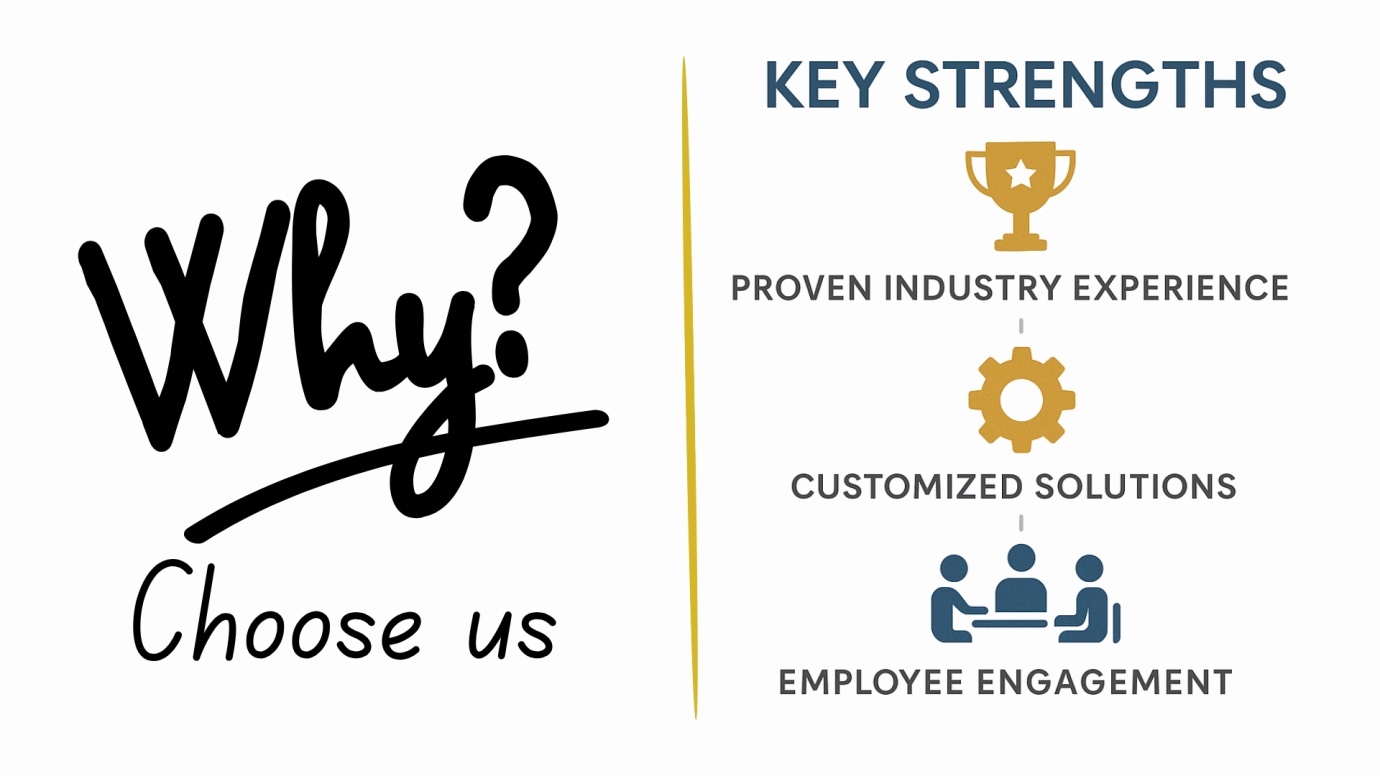
Here’s how Sugoya India empowers you to unlock the full potential of method study:
Comprehensive Process Improvement Expertise
Our specialists have hands-on experience using the latest method study techniques and tools, including:
- Detailed process charts and flow diagrams.
- Motion and SIMO charts for precision analysis.
- String diagrams to optimize layouts.
By integrating these proven method study techniques, we identify waste, reduce unnecessary motions, and design streamlined workflows that align perfectly with lean manufacturing principles.
Why Partner with Sugoya India?
- Proven Industry Experience: Years of success in diverse sectors, including manufacturing, logistics, and services.
- Customized Solutions: We tailor each project to your unique goals, workforce, and resources.
- Employee Engagement: We believe real improvement happens when people are involved. We train and guide your team throughout the method study steps to encourage ownership and smooth adoption of new practices.
Tailored Consulting for Various Industrial Studies
While method study is a core area, we also offer expert consultation for:
- Time Study: Time Study focuses on determining the standard time required to complete a task under specified working conditions. This helps businesses set realistic benchmarks, balance workloads, and improve labor productivity. Dive deeper into our Time Study blog for detailed methods and industry examples.
- Motion Study: Motion Study analyzes the individual movements within a task to eliminate unnecessary motions and design more ergonomic workflows. It works hand-in-hand with method study for maximum productivity gains. Check out our Motion Study guide to see how you can refine every motion for efficiency.
- Work Sampling Method: Work Sampling is a statistical technique used to estimate the proportion of time spent on different activities. It’s ideal for jobs that are non-repetitive or when direct observation isn’t feasible for extended periods. Read our Work Sampling blog to understand its practical uses and benefits.
- PMTS (Predetermined Motion Time Study): PMTS uses established data to set standard times for basic human motions, removing the need for continuous direct timing. It’s widely used in repetitive manufacturing and assembly tasks. Our PMTS (Predetermined Motion Time Study) blog explains how to use this powerful tool to optimize work standards.
- MOST (Maynard Operation Sequence Technique): MOST is an advanced form of PMTS that provides a faster way to measure work content by analyzing sequences of movements rather than each individual motion. It’s perfect for high-volume operations. See real-world applications in our MOST (Maynard Operation Sequence Technique) blog for better cost control and workflow design.
- Quality and Productivity Improvement Projects: Beyond formal studies, we deliver customized consulting to tackle specific quality and productivity challenges. From process audits to lean manufacturing and Six Sigma practices, we help you achieve measurable improvements.
Our holistic approach ensures that all aspects of your operations work together seamlessly for maximum efficiency.
Whether you’re taking your first steps toward structured process improvement or ready to upgrade your existing practices with advanced method study techniques, Sugoya India is here to help. Together, we’ll identify opportunities for efficiency, reduce waste, and boost productivity — setting your business up for sustainable growth and success.
FAQs
A. Method study is the systematic analysis of how work is done so that tasks can be performed more efficiently and cost-effectively. It’s about working smarter by using structured method study steps and proven method study techniques to eliminate wasteful actions.
A. In industrial engineering, method study is vital for improving productivity, reducing operational costs, and optimizing workflows. It helps industries achieve lean manufacturing goals and maintain consistent quality.
A. While both are part of work study, method study focuses on the whole process, whereas motion study analyzes individual movements within a task. Together, they improve workflow and ergonomics.
A. Method study in industrial engineering is widely used in manufacturing, healthcare, banking, logistics, and even agriculture — basically anywhere tasks can be streamlined and waste reduced.
A. ECRS stands for Eliminate, Combine, Rearrange, and Simplify — it’s a guiding principle used during the Develop stage of the method study steps to create better work methods.
A. Absolutely! Small businesses can use basic method study techniques to remove unnecessary tasks, improve productivity, and compete with larger companies more effectively.
A. Method study isn’t a one-time effort. To achieve continuous improvement, you should revisit the method study steps regularly, especially when processes or workloads change.
A. The biggest challenge is often employee resistance to change. That’s why involving workers throughout the method study steps and demonstrating clear benefits is crucial.
A. Ideally, a trained industrial engineer or process improvement specialist should lead it, but involving frontline workers ensures practical insights and smoother adoption of new methods.
A. Sugoya India guides you through all method study steps, applies the best method study techniques, and offers practical solutions based on real method study examples to help your business work smarter.
Conclusion
In a world where efficiency and competitiveness determine success, method study remains one of the most reliable ways to unlock hidden potential in your processes. It’s not about forcing your teams to work harder — it’s about empowering them to work smarter, using a systematic approach that delivers consistent, measurable improvements.
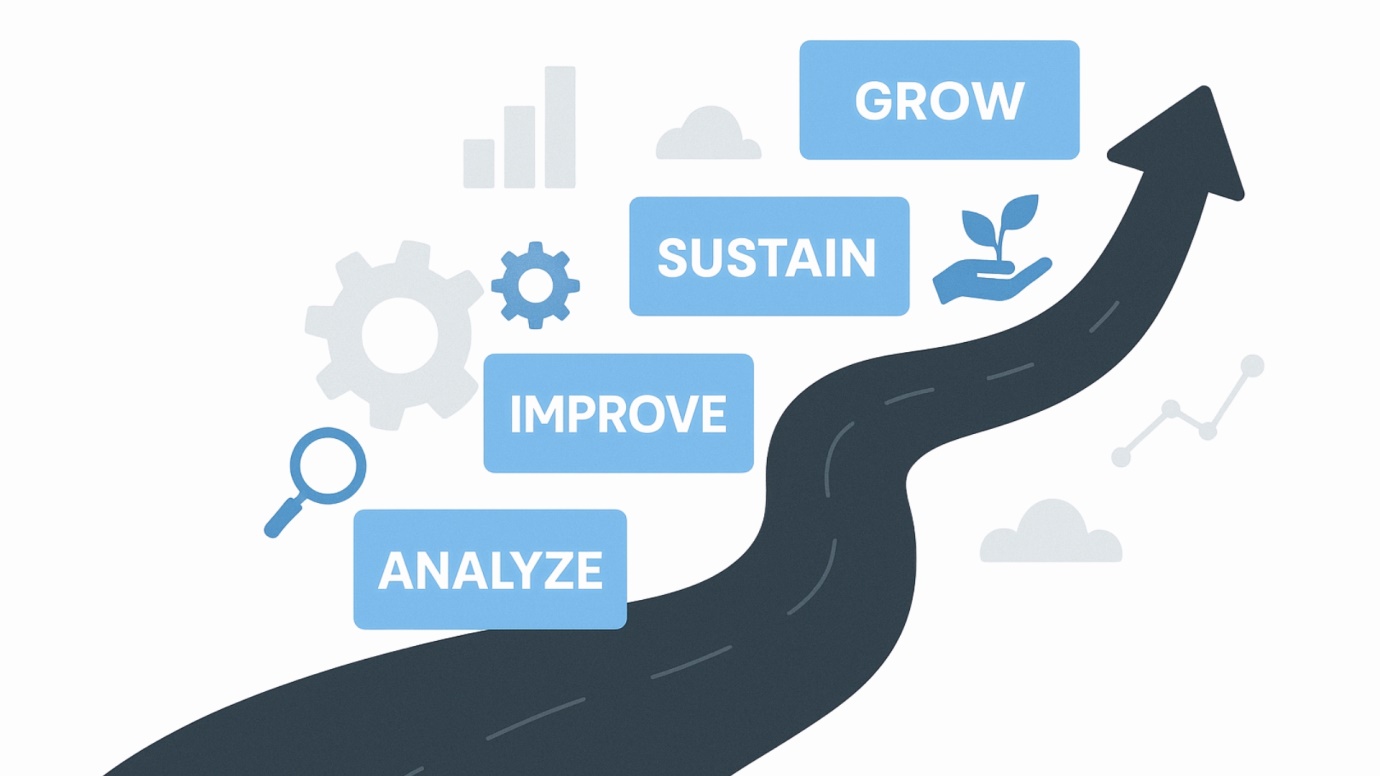
By following well-structured method study steps and applying practical method study techniques, businesses of all sizes can streamline operations, reduce waste, optimize resources, and create safer, more productive workplaces. From detailed process charts to advanced motion analysis, the tools and principles of method study provide a roadmap for organizations to achieve operational excellence — one step at a time.
The greatest advantage of method study is that it’s not a one-time fix; it’s a continuous improvement mindset. Whether you’re in manufacturing, services, or administrative operations, investing in systematic process improvement means you’re investing in your people, your bottom line, and your future growth.
At Sugoya India, we believe that success is built on practical solutions and people-driven results. Our experienced team is here to guide you through every part of your method study journey — from selecting the right processes to analyze, to applying proven method study techniques, and ensuring improvements stick with continuous follow-up.
Don’t let outdated workflows hold your business back. Partner with Sugoya India today to discover how our customized method study steps and process improvement expertise can help you boost productivity, reduce costs, and stay ahead in a competitive market.
Contact us now to start working smarter — not harder — with Sugoya India as your trusted industrial solutions partner.
To learn more about Sugoya India and our expert consultation services, visit our Homepage.

